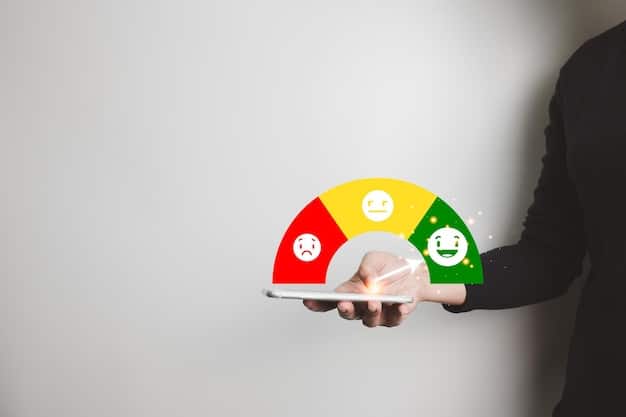Boost Customer Retention: 5 Strategies to Cut Churn by 15%

Boosting customer retention involves implementing strategic initiatives, such as personalized customer experiences, proactive communication, loyalty programs, feedback mechanisms, and efficient issue resolution, to significantly reduce churn rates and enhance long-term customer relationships, aiming for measurable improvements in customer loyalty and business sustainability, such as a 15% churn reduction in the next quarter.
Is your customer retention rate keeping you up at night? High churn can be a silent killer for businesses. But what if you could flip the script and not only retain more customers but also see a tangible reduction in churn? Boosting customer retention: 5 Proven Strategies to Reduce Churn by 15% in the Next Quarter is entirely possible with the right approach. Let’s dive into actionable strategies that can transform your customer relationships and improve your bottom line.
Understand Customer Churn and Its Impact
Before implementing any retention strategies, it’s crucial to understand why customers are leaving. Customer churn, the rate at which customers stop doing business with a company, can significantly impact revenue and profitability. Analyzing churn helps identify pain points and areas for improvement.
Identifying Reasons for Customer Churn
Several factors can contribute to customer churn. These include poor customer service, unmet expectations, pricing issues, and competition. Gathering feedback and evaluating customer behavior provides insights into why churn occurs.
The Financial Implications of Churn
High churn rates not only reduce revenue but also increase acquisition costs. It’s often more expensive to acquire a new customer than to retain an existing one. Understanding the financial impact can emphasize the importance of retention efforts.
- Reduced revenue streams due to lost customers.
- Increased costs for acquiring new customers.
- Negative impact on brand reputation and customer lifetime value.
- Decreased profitability due to higher operational costs.
By understanding the underlying reasons and financial implications of customer churn, businesses can strategically address the issues and prioritize customer retention efforts to foster long-term growth and stability.

Personalize Customer Experiences
Personalization involves tailoring interactions and offerings to meet individual customer needs and preferences. By delivering personalized experiences, businesses can foster deeper connections and increase customer satisfaction. When strategies are put in place, it emphasizes boosting customer retention.
Segmenting Your Customer Base
Dividing your customer base into segments based on demographics, behavior, and preferences allows for targeted personalization efforts. This ensures that each customer receives relevant and valuable experiences.
Customizing Interactions and Offers
Customizing interactions and offers based on customer data can significantly enhance engagement. This includes personalized emails, product recommendations, and tailored customer service.
- Personalized email campaigns based on customer purchase history.
- Product recommendations that align with individual customer preferences.
- Customized customer service based on past interactions and needs.
- Tailored loyalty programs with unique rewards and benefits.
Personalizing customer experiences creates a sense of value and appreciation, driving loyalty and reducing the likelihood of churn. By leveraging data and technology, businesses can create meaningful interactions that resonate with each customer.
Implement Proactive Communication Strategies
Proactive communication involves reaching out to customers before they encounter issues or have a chance to churn. By anticipating needs and providing timely support, businesses can demonstrate their commitment to customer satisfaction.
Regular Check-Ins and Support
Establishing regular check-ins and providing ongoing support ensures that customers feel valued and supported. This includes proactively addressing concerns and offering assistance.
Providing Value-Added Content
Sharing value-added content, such as helpful tips, guides, and resources, can keep customers engaged and informed. This demonstrates expertise and builds trust.
Proactive communication fosters stronger customer relationships and ensures that customers remain informed and supported, leading to increased satisfaction and retention.

Develop a Robust Loyalty Program
Loyalty programs reward and incentivize customers for their continued business. By offering exclusive benefits and rewards, businesses can encourage customers to stay loyal and reduce the temptation to switch to competitors. Investing in loyalty programs aids boosting customer retention.
Tiered Rewards and Recognition
Implementing a tiered rewards system allows customers to earn greater benefits as they increase their engagement. This encourages ongoing participation and loyalty.
Exclusive Benefits for Loyal Customers
Offering exclusive benefits, such as early access to products, special discounts, and personalized experiences, can create a sense of exclusivity and appreciation.
- Tiered reward system with escalating benefits.
- Exclusive discounts and promotions for loyal customers.
- Early access to new products and services.
- Personalized experiences and dedicated support.
A well-designed loyalty program can significantly improve customer retention by rewarding loyalty and creating a sense of value and exclusivity. By continually enhancing and adapting the program, businesses can ensure that it remains relevant and engaging for their customer base.
Solicit and Act on Customer Feedback
Customer feedback provides valuable insights into areas where a business excels or falls short. By actively soliciting and acting on feedback, businesses can continuously improve their offerings and enhance customer satisfaction. This approach aids boosting customer retention.
Implementing Feedback Loops
Creating feedback loops ensures that customer input is consistently gathered, analyzed, and acted upon. This includes surveys, reviews, and direct communication channels.
Addressing Pain Points and Concerns
Promptly addressing pain points and concerns demonstrates a commitment to customer satisfaction. This involves resolving issues efficiently and implementing changes based on feedback.
- Regular customer surveys to gather feedback on products and services.
- Analysis of customer reviews and testimonials to identify trends.
- Direct communication channels for addressing concerns and inquiries.
- Swift resolution of issues and implementation of feedback-driven changes.
By actively soliciting and acting on customer feedback, businesses can show that they value customer opinions and are committed to continuous improvement. This fosters trust and loyalty, reducing the likelihood of churn.
Efficiently Resolve Issues and Complaints
How quickly and effectively a business resolves issues and complaints can greatly influence customer retention. Providing prompt and satisfactory resolutions demonstrates a commitment to customer satisfaction and service quality. Addressing concerns effectively bolsters the strategy of boosting customer retention.
Streamlining Support Processes
Streamlining support processes ensures that issues are resolved quickly and efficiently. This involves implementing clear procedures, empowering support staff, and utilizing technology to manage inquiries.
Empowering Support Staff
Empowering support staff to make decisions and resolve issues independently can significantly improve response times and customer satisfaction. This builds confidence and trust.
- Clear and efficient procedures for issue resolution.
- Empowered support staff with decision-making authority.
- Use of technology to manage inquiries and track progress.
- Prompt and empathetic communication with customers.
Efficiently resolving issues and complaints demonstrates a commitment to customer satisfaction, fostering loyalty and reducing the likelihood of churn.
| Key Point | Brief Description |
|---|---|
| 💡 Personalization | Tailor experiences to individual customer needs. |
| 💬 Proactive Communication | Reach out before customers have issues. |
| 🎁 Loyalty Program | Reward customers for continued business. |
| 👂 Customer Feedback | Actively solicit and apply customer input. |
Frequently Asked Questions
▼
Customer churn is the rate at which customers stop doing business with a company. Managing churn is critical because acquiring new customers is more expensive than retaining existing ones, impacting profitability and growth profoundly.
▼
Personalization creates deeper connections by tailoring experiences to individual needs, increasing customer satisfaction and loyalty. Customized offers, product recommendations, and communications ensure customers feel valued and understood, and that they are boosting customer retention.
▼
Proactive communication demonstrates care and anticipates needs, preventing issues and fostering trust. Regular check-ins and value-added content keep customers engaged, reducing the likelihood of them seeking alternatives, reinforcing their value with boosting customer retention.
▼
Loyalty programs incentivize continued business through exclusive rewards and recognition. Tiered systems and special benefits create a sense of exclusivity, encouraging customers to stay loyal and engaged rather than switching to competitiors.
▼
Acting on customer feedback shows that a business values customer opinions and is committed to improvement. This builds trust and ensures that products and services continually meet customer needs, supporting boosting customer retention and satisfaction.
Conclusion
Boosting customer retention requires a multifaceted approach that focuses on understanding customer needs, delivering personalized experiences, and fostering strong relationships. By implementing these five strategies, businesses can combat churn, enhance loyalty, and drive sustainable growth.





